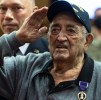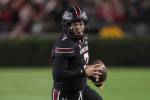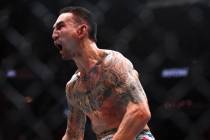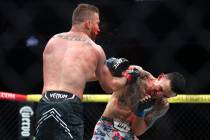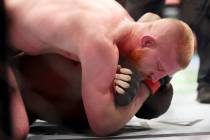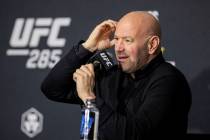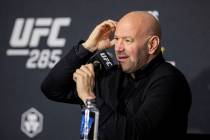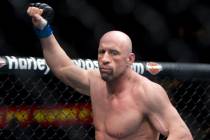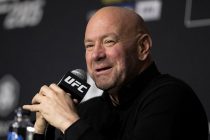The UFC’s anti-doping program, a year later

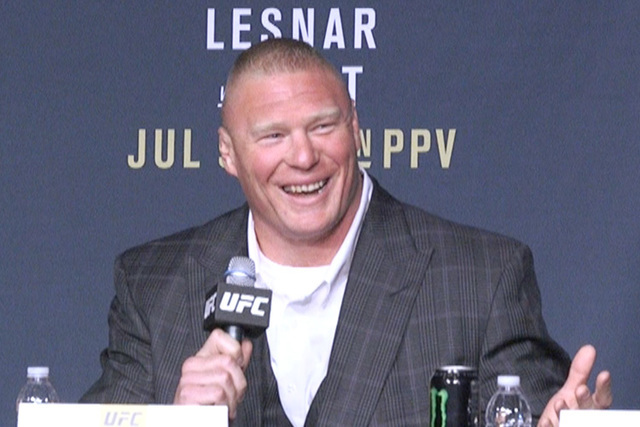
In announcing the implementation of a comprehensive year-round drug testing program last year, UFC CEO Lorenzo Fertitta famously said the situation was going to get worse before it got better.
Perhaps he was peering into a crystal ball more than a year in the future at UFC 200 when he made the comment.
TESTING POSITIVE
Former light heavyweight champion Jon Jones was pulled from the headlining bout just three days before the historic event at T-Mobile Arena when it was revealed he had failed an out-of-competition drug test.
Heavyweight Brock Lesnar returned from retirement on the card and won a unanimous decision over Mark Hunt, only to have it revealed about a week later he had failed both an out-of-competition test and one administered the night of the fight.
It cast a dark shadow over what should have been a celebratory weekend that included two other live cards and the announcement of a $4 billion sale of the company to Hollywood conglomerate WME-IMG.
ANTI-DOPING PROGRAM DOESN’T DISCRIMINATE
The unfortunate situations did at least show the organization’s anti-doping program, which went into effect in July 2015 and is administered independently by the United States Anti-Doping Agency, doesn’t discriminate when it comes to revealing potential violations from the UFC’s biggest names.
Jeff Novitzky, best known for his role in the investigations of Lance Armstrong and BALCO, was hired as the UFC’s Vice President of Athlete Health and Performance in April 2015. He helped work with USADA to spearhead the implementation of what is touted by the UFC as the most comprehensive anti-doping program in all of professional sports.
While the positive tests could be viewed as a signal the program is working, the headlines of some of the sport’s biggest stars facing lengthy suspensions are difficult to overlook.
“More recently, we’ve had some really high-profile potential violation announcements that really affected maybe our biggest show ever so that definitely bumped and bruised,” he said. “But if you look at a scope of what we’ve done over this past year and you look at the percentage of violations, the percentage is relatively low. That’s not saying you’re catching every single thing that’s happening, but I think it’s promising based on the volume of testing and how few violations we’ve had.”
IS IT WORKING?
As of July 20, USADA had administered 1,418 doping control tests to 634 athletes in just over a year. Seven athletes have received sanctions to date, including BJ Penn, who was suspended when he self-reported the use of an IV. That number doesn’t include Jones and Lesnar, who are awaiting adjudication of their cases. It also doesn’t include George Sullivan, who was pulled from an event last week when the list of supplements he submitted before his fight allegedly included one deemed to be of high risk by USADA and he was pulled from a card.
The success of the program shouldn’t necessarily be judged by positive tests, according to USADA spokesman Ryan Madden.
“From the outset, our goal for the program was for it to be the most comprehensive of its kind in professional sports,” he said. “I think we have taken positive steps to accomplish that. There’s clear signs the program is working and that clean athletes’ rights are being protected like never before. Ultimately what you want out of a program is not just to catch people breaking the rules, but you also want to deter another set of athletes that may have considered breaking the rules to not do so just by virtue of there being in place a quality, effective, anti-doping program.”
Both USADA and the UFC believe they are on the right track to doing so, though they admit there is still room for improvement.
UFC heavyweight Roy Nelson, who has long been a proponent for more strict drug testing in the sport, agrees.
“It’s definitely better than before, but it can always be better,” the Las Vegan said. “It’s like when you get a raise, you can always still get more money.”
He said red flags were raised for him when Lesnar’s test result wasn’t revealed until after he had competed.
Nelson believes a better route may have been to empower athletic commissions, which do still conduct testing independently, to expand their programs to eliminate any appearance of possible collusion between USADA and the UFC. He also thinks that there needs to be more targeted testing of athletes who are widely believed to be skirting the rules.
According to both USADA and the UFC, inquiries are being made about the possibility of expediting the process of receiving test results, particularly when out-of-competition tests are taken close to a fight date. There can’t be a blackout date, however, where fighters won’t be tested a certain number of days before a fight because it makes the testing process too predictable.
Novitzky stressed test results have never been held back by either USADA or the UFC. The program is also expanding.
The third quarter of 2016 will mark the beginning of the full implementation of the program with 700 tests planned as part of a target of around 2,800 per year going forward.
Fighters are required to share their location with USADA through an app at all times and can be tested at any time and just about any place in the world whether there is a fight scheduled or not.
Novitzky believes the program, which also includes an extensive educational element that is ongoing, is without a doubt the best in professional sports.
“There’s some sports out there doing some good things,” he said. “I don’t want to make it like they’re doing no good in terms of anti-doping, but there’s no other sport that matches up to what we’re doing in terms of the scope of the testing, the number of tests performed on our athletes, the true 365-day, 24-hour-a-day testing that we have. There is no predictability in terms of when USADA is coming to take a collection. You can’t say that for these other sports and that’s imperative for a good testing program.”
Madden adds the fact the UFC is left completely out of the testing and adjudication process is a major factor in the program’s strength.
Novitzky said education is still a major focus of the program, particularly when it comes to supplements and the reach of the testing program. The importance of fighters knowing exactly what they are putting in their bodies at all times and what is at stake for rulebreakers is stressed at seminars, mandatory online refresher courses and Novitzky’s in-person meetings during fight weeks.
“The education process is a deterrent on the front end,” he said. “When our athletes figure out how comprehensive this program is, in a perfect world, that works right there. You don’t have to have positive tests to show the back end is working. If you have a real comprehensive program without a lot of positive tests, that means the deterrent is working.”
And it keeps the headlines from being so ugly.
Contact reporter Adam Hill at ahill@reviewjournal.com or 702-224-5509. Follow @adamhilllvrj on Twitter.
RELATED ITEMS
NFL veteran, brother of embattled UFC star, suspended for PED violation
Former UFC champ Jon Jones tested positive for 2 banned estrogen blockers, faces 2 year suspension
Former UFC heavyweight champ Lesnar flagged for potential anti-doping policy violation
Former UFC heavyweight champ Brock Lesnar flagged for 2nd failed test
UFC featherweight Chad Mendes suspended 2 years by USADA
Welterweight George Sullivan pulled from UFC on Fox 20 for potential USADA violation
Means pulled from UFC main event due to potential Anti-Doping policy violation
World Anti-Doping Agency recommends banning all Russian athletes from Rio Olympics
45 more athletes caught for doping after retests from Beijing, London Olympics
Tennis star Maria Sharapova banned 2 years for doping, will appeal



